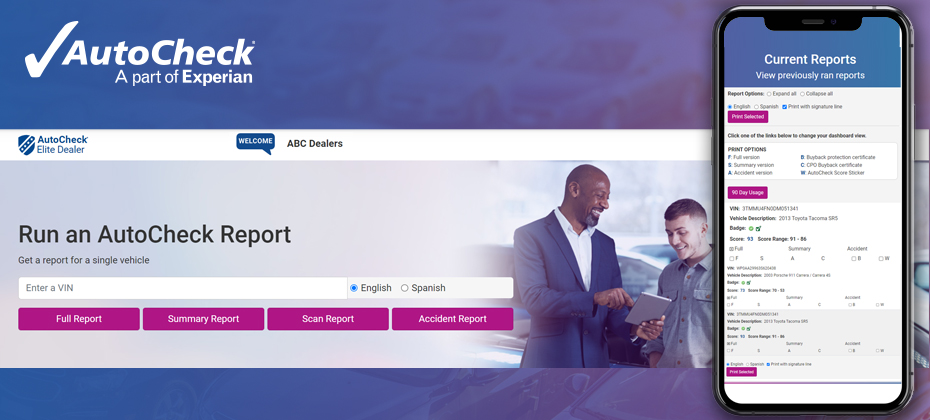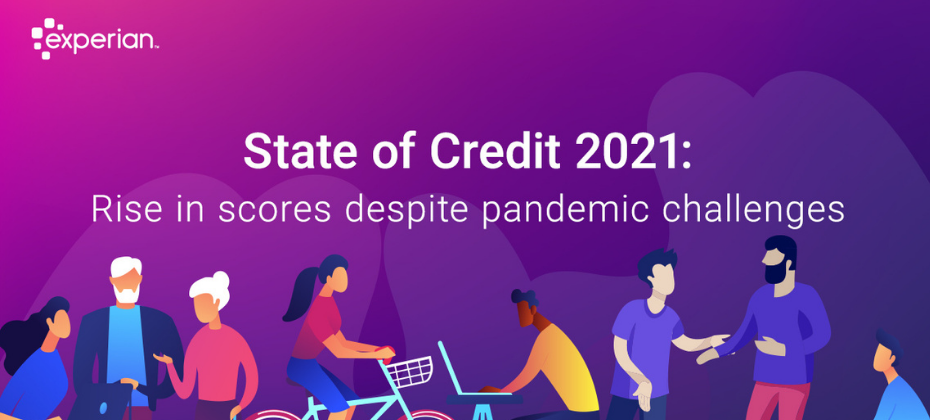Latest Posts

We’re excited to announce that the AutoCheck Member Website has received a facelift! AutoCheck has always been the industrial strength Vehicle History Report that automotive professionals trust to help manage risk and confidently buy and sell the right vehicles. We’ve made this great solution even greater by improving our Member Site user experience. Based on extensive research and user feedback, we’ve added many visual and workflow enhancements which make it easier for users to use the site. One noticeable change to the Member Website is the addition of Experian’s brand and color scheme. You’ll know right away that you’re accessing AutoCheck data backed by Experian, the industry experts for reliable data. The entire site is now mobile responsive—optimizing the experience for tablet and mobile users to provide even more shopping convenience. The new site will allow full functionality from a tablet or mobile device. As always, subscribers can continue to access AutoCheck reports via our mobile app or AutoCheck Fast Link℠ integration within their DMS, CRM, inventory management, online vehicle listings or many other integrated solutions. In addition, the AutoCheck Member Website is now WCAG 2.1 compliant. Web Content Accessibility Guidelines (WCAG) were developed to make web content more accessible to people with disabilities. This ‘web content’ usually refers to text, images and sounds on a webpage or web application. It also may include code that defines structure and presentation of the page of application. While a generated AutoCheck was already WCAG2.1 compliant, the entire member site now also meets the accessibility guidelines. AutoCheck Members can expect the same great functionality once they have signed into the site: Run single or multiple reports Print and email AutoCheck reports Print the Buyback Protection Certificate and the AutoCheck Score Sticker View the Track their 90-day usage Access AutoCheck brand materials including logos, videos and showroom materials Review Best Practices and Frequently Asked Questions Update account information …and much more! Below are a couple of examples which highlight the new user experience. Already an AutoCheck Member? Contact us or call us at 1.888.409.2204 if you have any questions about navigating the redesigned website. Not an AutoCheck subscriber? Contact us to become an AutoCheck client and take advantage of all the benefits.

As today’s fastest-growing form of criminal activity, cybercrime is expected to cost organizations $6.1 trillion worldwide this year alone,1 with attacks on enterprises now occurring every 11 seconds2. But despite increasingly widespread growth in corporate IT security awareness, the importance of putting a sound data breach preparation plan in place for protecting your customers’ privacy and data can’t be underscored enough. Given the scale of IT security threats, it bears reminding: Network compromise is now largely a matter of when, not if for most businesses. As a result of this shift in security and operating environments, it’s important for enterprise leaders to note the six key reasons that most data breach responses fail: No Budget: Despite the seeming inevitability of a data breach, most companies’ average annual budget for a consumer response is exactly $0. Many companies and security teams believe they are fully prepared or won’t be targeted. But with losses due to ransomware attacks up 225% lately in the US alone3, it can be an expensive gamble to make. Never Tested: Even if a company does have a data breach response plan in place, it’s not usually been stressed-tested via live exercises and drills. Having a plan in place is a great first step, but unless you test it in a live breach simulation or exercise, you can’t be certain the plan will be successful. Unknown Impact: It can be hard to know how much of your customer population has been impacted by the breach. Your plan needs to be flexible enough to accommodate both small and massive breaches. No Estimate: Data breach responses also fail because there is no estimate for the scale of phone calls, emails, and complaints that may be received. To put things in perspective: A small data breach is MUCH different and easier to remedy than a one involving millions of records. Slow to Respond: By law, firms that suffer a data breach must now report the incident to government authorities within 72 hours. Failure to address increasing regulatory compliance and information sharing needs (which demand greater oversight and overhead from organizations), can come with hefty fines. No SLAs: Companies often don’t have the necessary agreements to guarantee the infrastructure and staff to assist consumers with resolving their cases. Having a dedicated, guaranteed number of call center agents ready to go when a company experiences a data breach is invaluable. To improve your odds of successfully defending against and responding to breaches, you’ll want to focus on strengthening four areas of operations: Guarantee Resources: Ensure that you have dedicated security resources and prepared to react to threats on the turn of a dime. Your SLAs should include well-trained, certified call center agents and the infrastructure ready to go. This should include scalable and high quality identity protection services to resolve harm to your customers. Readiness Testing: Failing to plan (i.e. not stress-testing your recovery plan prior to incidents occurring) is like planning to fail. By rehearsing your disaster response and recovery strategies, you’ll be able to identify any points of failure and shortcomings that you can improve upon before actual concerns arise. Regulatory Needs: Emphasize quick and accurate responses to regulator inquiries by understanding the specifics for your industry and business. Communications: Having a corporate communications plan ready to go in real-time is also key. Connect with your communications team to create a communications response plan prior to any incidents occurring so that all you largely need to tweak are specifics on the day of the event. According to studies by IBM, companies can save $1.2 million off the cost of data breaches by having an incident response plan in place and extensively testing it before cyber threats strike. Bearing this in mind, the best defense against digital dangers is a good offense. Experian’s Reserved Response™ was created to help organizations take a proactive approach to data breach response planning. Deploy it to put an end-to-end game plan in place and implement a step-by-step playbook that workers can follow in the event of an incident. You’ll also guarantee that your organization gains the necessary manpower, infrastructure, and response readiness needed to ensure ongoing network resilience and a speedy recovery should disaster strike. 1 Cybersecurity Ventures, Annual Cybercrime Report 2020 2 Cybersecurity Ventures, Cybercrime to Cost the World $10.5 Trillion Annually by 2025 3 Cyberreason, Ransomware: The True Cost to Business Study 2021

Despite an unprecedented 18 months since the pandemic was in full force and many Americans were sent home, financial wellness continues to be on the up and up. Consumers continue to manage credit well and the average credit score climbed seven points since 2020 to 695, the highest point in more than 13 years. In Experian’s 12th annual State of Credit report, the headlines are hopeful regarding how Americans are managing personal finances in the face of the pandemic. The report provides a comprehensive look at the credit performance of consumers across America by highlighting consumer credit scores and borrowing behaviors. This year’s report features data from 2019 pre-pandemic, the 2020 pandemic year, and the start of 2021. “The findings from this year’s report show something I’ve always believed: Americans are resilient, for the most part they make smart decisions in the face of adversity and they are agile in adjusting their financial habits when the environment or circumstances change,” said Alex Lintner, President, Experian Consumer Information Services. Highlights of Experian’s State of Credit report: 2021 State of Credit Report 2019 2020 2021 Average VantageScore® credit score [1] 682 688 695 Median VantageScore® credit score 687 697 707 Average number of credit cards 3.0 3.0 3.0 Average credit card balance $6,494 $5,897 $5,525 Average revolving utilization rate 30% 26% 25% Average number of retail credit cards 2.50 2.42 2.33 Average retail credit card balance $1,930 $2,044 $1,887 Average nonmortgage debt $25,057 $25,483 $25,112 Average mortgage debt $210,263 $215,655 $229,242 Average auto loan or lease $19,034 $19,462 $20,505 Average 30–59 days past due delinquency rates 3.8% 2.4% 2.3% Average 60–89 days past due delinquency rates 1.9% 1.3% 1.0% Average 90–180 days past due delinquency rates 6.6% 3.8% 2.5% We asked Joseph Mayans, Principal Economist at Advantage Economics, LLC, for his reactions to the findings: “The State of Credit Report captures the three central themes of the pandemic. First, it shows the overwhelming success of the fiscal support packages. By far, the most striking example of this is the broad based and significant decline in delinquencies during a time when millions of people were out of work. Second, the report showcases the resiliency of American households. People used their stimulus dollars to stay on top of their bills and pay down debt, which boosted average credit scores across all generations. And third, it highlights the unique behavioral shifts brought on by the pandemic. We can see these changes in the rise of housing and auto debt as people bought larger homes and sought to drive rather than ride public transportation.” Generational Trends As indicated in the findings, consumers across all generations except Gen Z saw decreased utilization rates and decreased credit card balances year over year. Consumers are also missing fewer payments with notable improvements seen among the youngest consumers. Mortgage debt was up across every generation, which may correlate with the record low interest rates on mortgages, refinances and moves. According to the CBRE, “the pandemic accelerated several long-standing American migration patterns” as evidenced by more than 15.9 million people filing change-of-address requests with the United States Postal Service. Compared with 2019, 2020 change-of-address requests show a 4% increase in total movers, 2% increase in permanent movers and 27% increase in temporary movers, according to a study by MyMove. Mayans also made note of the mortgage trends. “It’s becoming clearer that millennials are stepping into the homebuying phase in a big way. Once thought to be the generation of apartments and urban revival, many older millennials are now buying homes and moving to the suburbs much like their parents before them,” Mayans said. “This will have significant implications for the post-pandemic world, especially as work from home becomes more prevalent.” State Trends The states with the highest and lowest average credit score remained unchanged from last year with the highest average score of 726 held by Minnesota and an average score of 666 held by Mississippi. New Jersey had the highest number of credit cards and retail cards at 3.37 and 2.54 respectively, and Alaska had the highest credit card debt at $7,089 (U.S. average is $5,525) and Texas had the highest retail debt at $2,248 (U.S. average is $1,888). What Lies Ahead Some have argued that the past year of the pandemic and quarantine forced a lot of time for reflection. The continued positive trends of consumer behavior seem to indicate some of that effort was put toward better financial health practices. That said, like any sourdough bread recipe or DIY home glow-up, there’s always more to learn and opportunities to seize when it comes to financial health. “We are committed to working with lenders and the industry to help consumers gain access to credit, driving broader financial inclusion, while also teaching consumers how to responsibly build and use credit responsibly,” Lintner said. In addition to the free weekly credit report at AnnualCreditReport.com, Experian also offers consumers free access to their credit report and ongoing credit monitoring at Experian.com. Additional credit education resources and tools Join Experian’s #creditchat hosted by @Experian on Twitter with financial experts every Wednesday at 3 p.m. Eastern time. Bilingual and Spanish speakers are also invited to join Experian’s monthly #ChatdeCredito hosted on Twitter at 3 p.m. Eastern time beginning September 16. Visit the Ask Experian blog for answers to common questions, advice and education about credit. Add positive telecom, utility and streaming service payments to your Experian credit report for an opportunity to improve your credit scores by visiting experian.com/boost[2] For additional resources, visit https://www.experian.com/consumereducation To see all the findings, download the 2021 State of Credit Report. Download the full report [1] VantageScore® is a registered trademark of VantageScore Solutions, LLC. VantageScore® credit score range is 300 to 850. [2] Results may vary. See Experian.com for details

Your local auto market changes every day. Today’s challenge is securing the inventory needed to keep new and repeat customers coming in the door. Tomorrow it might be finding the right customers for the inventory you have secured. Either way, understanding the competitive activity in your market is key to developing ongoing strategies for success. Important competitive insights include the ability to: • Gauge your performance against the competition by identifying each unit registered in your market • Discover what vehicles are popular among your consumers by make and model • Identify the key characteristics of customers in your area. In yet another benefit, Experian provides our AutoCheck Elite dealer clients with complimentary access to in-depth market reporting, including these comprehensive reports: The AutoCount Market Ranking Report Learn whether you’re getting your share of vehicle sales in your local market’s top zip codes. This report: • Lists all sales activity within a 15-mile radius of your dealership • Provides unbiased monthly information from state DMVs on new and used vehicle sales • Includes access to our web-based portal to provide instant access to a variety of customizable reports • Identifies vehicle registration by ZIP code to pinpoint marketing opportunities The AutoCount Vehicle Model Ranking Report Stock the right inventory by learning what vehicles are popular among your consumers (see example below). This report: • Provides an expanded view of the dealership’s market, which leads to more informed decisions that maximize untapped profit potential • Track the top 25 new and used vehicles within a 15-mile radius of your dealership as well as the top gainers and losers in the market • Offers an easy-to-read graphical summary of critical market information, including lender ranking • Gives an unbiased scorecard of dealership performance in the local market to determine market share and competitive insight Having access to monthly DMV reports and analysis can help deliver a competitive edge to your dealership. To become an AutoCheck member today, contact us or call 1.888.409.2204.

The automotive finance market is beginning to level out to pre-pandemic trends in Q2 2021.

The collections landscape is changing as a result of new and upcoming legislation and increased expectations from consumers. Because of this, businesses are looking to create more effective, consumer-focused collections processes while remaining within regulatory guidelines. Our latest tip sheet has insights that can help businesses and agencies optimize their collections efforts and remain compliant, including: Start with the best data Keep pace with changing regulations Focus on agility Pick the right partner Download the tip sheet to learn how to maximize your collections efforts while reducing costs, avoiding reputational damage and fines, and improving overall engagement. Download tip sheet

As last year’s high-volume mortgage environment wanes, lenders are shifting focus to address another set of challenges. Continued economic uncertainty lingers as consumers navigate towards recovery. As such, mortgage lenders have less clarity than normal to assess risk and measure performance in their servicing portfolios. On top of that, more lenders are struggling with customer retention than ever before, due to a historically low rate environment in 2020. These combined factors create a new set of challenges servicers will face in the coming months. We explore a few of these challenges below. An incomplete picture of risk The CARES Act accommodation reporting structure has made it challenging for servicing teams to fully understand the impact of forbearance in their portfolios. If looking only at a CARES Act accommodated borrower’s credit profile, there is no indication whether that consumer would otherwise be delinquent or headed towards default. In turn, lenders cannot model out risk based on this information alone. Borrowers’ financial situations can still change rapidly, and some are still struggling to regain their financial footing. Property data also plays a part in a holistic view of risk. Partly due to lack of housing inventory, home equity continues to rise in many areas of the country, yet there is still uncertainty around whether prices are overinflated, whether the market will correct itself and by how much, and the impact the foreclosure moratorium may have on one’s portfolio. And property dynamics continue to change due to consumer migration stemming from the onset of virtual or hybrid work environments, where homeowners are less bound geographically to a place of work. Being able to have insight into a holistic view of risk is critical to navigating the upcoming months in mortgage servicing. Low borrower retention 2020’s prevailing low-rate environment continues to persist well into 2021 creating a big challenge for mortgage servicers in terms of borrower retention. Borrowers continue to be incentivized to refinance, and in some instances multiple times, to capture the savings throughout the life of their mortgage. Every time a borrower refinances, the lender who’s servicing the loan risks losing the borrower to another lender. This portfolio runoff can create losses for the lender; high portfolio run off rates have shown to negatively impact portfolio performance and investor credibility while increasing marketing cost for new customer acquisition. In our Mortgage in 2021 webinar, we point to the sheer magnitude of this – at the end of 2020, a whopping 33% of first mortgages were less than a year old. Additionally, with the uptick in the number of fintech mortgage lenders and aggregation websites, it has become increasingly easy for consumers to shop for alternative options. Being able to predict the consumers likely to refinance can help servicers retain existing customers and reduce losses. Lack of operational efficiency Lenders and servicers had to increase the capacity of their systems, oftentimes at the turn of a dime, due to last year’s record-breaking origination volumes. This led to massive growing pains while simultaneously stress-testing a company’s systems and processes. As a result, the overall cost to produce a mortgage has risen. Borrower data hygiene poses a challenge for many servicers as well. There was a lot of movement in 2020 in terms of mergers and acquisitions which may also affect servicers’ operational efficiency. Marrying several disparate data points during such events can lead to borrower data inconsistencies and duplicates across loan origination systems. And as consumers come out of forbearance or deferral status, servicers are managing more calls to their inbound call centers, increasing the scope of the problem. Having tools to ensure data accuracy and correct consumer contact information can help reduce operating cost. Conclusion There certainly is a lot of pressure on servicers to optimize and be in a position to efficiently help homeowners in need as forbearance and foreclosure moratoriums end. But with the right data, insights and partners, mortgage servicers can navigate these challenges all while managing risk and enabling the business to grow safely. In our next blog, we highlight what forward-thinking lenders and servicers are focusing on now to navigate the upcoming months in mortgage servicing. Learn more

The Telephone Consumer Protection Act (TCPA), which regulates telemarketing calls, autodialed calls, prerecorded calls, text messages and unsolicited faxes, was originally passed in 1991. Since that time, there have been many rulings and updates that impact businesses’ ability to maintain TCPA compliance. Recent TCPA Changes On December 30, 2020, the Federal Communications Commission (FCC) updated a number of TCPA exemptions, adding call limits and opt-out requirements, and codifying exemptions for calls to residential lines. These changes, along with other industry changes, have added additional layers of complication to keeping compliant while still optimizing operations and the consumer experience. Maintaining TCPA Compliance Businesses who do not maintain TCPA compliance could be subject to a lawsuit and paying out damages, and potential hits to their reputation. With the right partner in place, businesses can maintain data hygiene and accuracy to increase right-party contact (and reduce wrong-party contact) to keep collections streamlined and improve the customer experience. Using the right technology in place, it’s easier to: Monitor and verify consumer contact information for a better customer experience while remaining compliant. Receive and monitor daily notifications about changes in phone ownership information. Maintain compliance with Regulation F by leveraging a complete and accurate database of consumer information. When searching for a partner, be sure to look for one who offers data scrubbing, phone type indicators, phone number scoring, phone number identity verification, ownership change monitoring, and who has direct access to phone carriers. To learn more about how the right technology can help your business maintain TCPA compliance, visit us or request a call. Learn more

I woke up early this morning to get my run in on the treadmill before starting my day. As I listened to music on my Pandora account, I saw an advertisement for my local Ford dealer. Later in the week, I was streaming my favorite show, and on came an advertisement suggesting I service my vehicle at the same local Ford dealer. When I checked my email on Tuesday, I remembered I wanted to schedule my service. Then came the letter with an option to check the appraisal for my vehicle. Now, I am fully shopping!!! Why you ask? Because the marketing message across so many channels set the stage for my interest. According to Google, multi-channel users will have a 30 percent higher lifetime value compared to single channel users. As contemporary society grows more attached to streaming services, social media and their cell phones, it is imperative to market to consumers where they spend time. Why then do so many automotive marketing companies only offer direct mail and email? Simple− those two forms of communication have been around for decades and can be the most cost effective to provide. While direct mail marketing is effective, utilizing the power of social media, streaming services and other digital platforms effectively puts your message in front of consumers. While I can toss the letter on my desk for later reading, the video commercial during my television streaming cannot be set aside. Multi-channel marketing combines various platforms to amplify your campaign’s frequency and reach, creating more effective messaging. One channel is often not enough for a robust marketing campaign since audiences tend to frequent many different channels. Experian’s Automotive Intelligence Engine with Marketing Creative & Fulfillment executes the strategic marketing plan created in AIE with true multi-channel messaging. This end-to-end solution utilizes Experian’s world-class data to create a powerful, brand-specific marketing strategy that resonates with your buyers by reaching their inbox, mailbox, screen and desktop −where they spend the most time.

Over the last year and a half, strong trends emerged in how businesses and consumers interact online - specifically when validating identities and preventing fraud. We initially explored these trends at a global level, and now we've explored U.S.-specific insights into online security, the customer experience, and digital activities and operations. Download the North America findings report to learn more about business and consumer fraud and identity trends impacting the way we live, work, and interact. Review your fraud strategy

Millions of consumers lack credit history and/or have difficulty obtaining credit from mainstream financial institutions. As a result, the use of expanded Fair Credit Reporting Act (FCRA) – or alternative – data has continued to gain popularity among lenders and financial intuitions to enrich decisions across the entire lending lifecycle to meet the financial needs of their consumers. Experian presented in a recent webinar hosted by AFSA, where Alpa Lally, Vice President of Product Management, and David Elmore, Automotive Solutions Consultant, had a chance to speak about the benefits of FCRA data, and ways lenders can leverage this data to ease access to credit for “invisible” and below prime consumers. Watch the full webinar, “FCRA Data: The Key to Unlocking Credit Universe” and learn more about: How expanded FCRA data is being used throughout the lending lifecycle The benefits of leveraging FCRA data including providing a more holistic view of a consumer’s credit profile and behavior beyond financial services, leading to smarter, more informed lending decisions The lift FCRA data can offer when augmented with traditional credit data This webinar is a part of AFSA’s partner webinar series. To learn more about FCRA data and explore related content, please visit our FCRA Alternative Credit Data Resources Page. Learn More About FCRA-Alternative Credit Data

Have you ever wanted to ask a customer to sign an AutoCheck vehicle history report to indicate they have received and reviewed the report and they are aware of the status of the vehicle they are purchasing?

As lenders and consumers emerge from the pandemic, predicting the attributes of the “new normal” will be difficult. Consumer demand, credit characteristics and economic conditions have all been affected by the pandemic – changing the way we think about doing business. Regulators and legislators have also developed new priorities and expectations for financial institutions. Clint Ivester, Experian’s Solutions Consultant and VP of Sales, joined Lee Gilley and Jonathan Kkolodziej, Partners for Bradley, to share their observations from the past year at AFSA’s 2021 Independents Conference. They also discussed recommendations financial institutions should consider to achieve the best possible posture with respect to compliance and business readiness. Here are a few Q&A highlights: Q: How are stimulus packages and increased government spending affecting economic conditions? A: [Ivester]: Our Experian forecast shows that the economy will grow 6% in 2021. That is well above the 2.5% average we have seen over the last four decades and highest rate since 1983. While the economy is oriented toward growth, how strong that growth is going to be will really depend on how well things go when the “training wheels” are taken off, how robust the recovery is for lower-income workers, and how consumer spending habits have been altered by the pandemic. *Data sources include Bureau of Economic Analysis and Experian’s “COVID-19 Economics Scenarios” April 2021 Report Q: How should businesses be assessing future consumer demand, conditions, and broader economic conditions over the next few quarters? A: [Ivester]: To answer this question, we should consider some factors including unemployment. What happens with lower income workers will have a big impact on where consumer spending goes post-stimulus. While the overall economy is set for solid growth there are still 8 million people out of work with the vast majority being lower income workers. Employment for lower income workers is still down more than 20%. These workers are set to lose the most by the phase out of the federal pandemic unemployment programs and are the highest risk to lose all unemployment benefits. However, if we see a strong jobs recovery – as is very possible – in bars, restaurants, hotels and other industries, these individuals will return to more normal spending habits and consumer spending should remain robust. *Data source includes Opportunity Insights Economic Tracker Watch the full session to hear more about the discussion. For more resources and content on this topic, please visit our Look Ahead Resources page or contact us for more information.

Ransomware needs to be on your radar. Here’s why. Ransomware review Ransomware is a cyberattack where cybercriminals take over an organization’s computer network with malware. Once they assume control, the criminals demand a ransom to restore the victim’s encrypted data access. With an estimated generation of $412 million in 2020 alone1, the frequency of these attacks is growing. At Experian, we handle many data breach cases and know that 7 of 10 breaches involve ransomware. This summer, NetDiligence dedicated a panel at its Cyber Risk Summit on the Lifecycle of a Ransomware Event and invited us to talk about our solutions to help business leaders prepare to minimize interruptions spurred by ransomware. The lifecycle of a ransomware attack includes five stages: 1. Attack Bad actors attack to discover assets, take data, extort it for direct payment, or profit from reselling data on the dark web. They can also launch a ‘double-take’ attack: first collecting ransom to access data and demanding secondary payment to keep it off the dark web. Hackers prey on company networks, searching for vulnerabilities and accessing encrypted files through phishing or planting malicious links to infect the network with malware. More than double the global rate of 14%2, U.S ransomware attacks have become more aggressive, accounting for 30% of all cyberattacks in 20202. At Experian, we’ve seen an even higher occurrence, with 59% of the events serviced 2021 to date involving ransomware. 2. Discovery Once attackers infiltrate a system, they demand a ransom for the decryption key to unlock the encrypted files. Companies usually discover the attack through a ransom note emailed to an executive, a file left on a server, or even a flashing warning on all connected computers. If they leave a message including their contact information, ransom sum, payment delivery time, and consequences for unmet conditions, such as tipping off the media, releasing stolen data, or selling it on the dark web. Next, companies will contact their cyber insurance carrier to log stolen information, get systems back online, navigate legal issues, and facilitate hacker negotiations. Since only about one-third of companies have cyber insurance, most will rush to hire cybersecurity counsel post-attack3, amounting to more stress and delays since it can take months for large companies or those without backups to determine the extent of the damage. At Experian, almost all events involving ransomware take about 20% more time to begin breach notification. Whether there is an incident plan in place or not, companies experience immense panic. 3. Negotiation Typically, a company will hire a professional, either directly or through their cyber insurance, to negotiate with hackers. While hackers expect price haggling, the ransom price could still be hefty. According to the cybersecurity firm, Coveware, the average ransom was $154,000 in Q4 2020, down from $230,000 the year before4. But hackers can drive up the price. Prime example: JBS, the world’s largest meat processor, paid an $11 million ransom in June 2021 to prevent customer data from being compromised. In a perfect world, the ransomware negotiation process goes this way: Establish communication with the attackers Obtain proof of decryption Obtain data exfiltration proof Negotiate a (huge) discount Celebrate Unfortunately, negotiations can be tricky, and the process rarely goes this way. Sometimes attackers go “dark” or request additional payments. Additionally, decryption tools may have bugs that skip mapped network drives or skip folders with long paths and unusual characters. An investigation is key to determine how hackers got in, what was exposed, and if they still have access—knowing exactly how and what was compromised will help in the negotiation. 4. Settlement After the ransom negotiations are over, companies must carefully consider the strategy behind the decision to pay or not to pay the ransom. The FBI generally discourages ransom payments because they may entice other criminals to engage in ransomware and paying does not guarantee data recovery. Additionally, the Office of Foreign Asset Control (OFAC) has payment bans and restrictions that support national security that must be upheld or face fines. At this stage, companies need to ensure that the ransom settlement does not violate constantly evolving regulations. If companies settle, the payment will typically be delivered via cryptocurrency like Bitcoin since it is harder to detect the payees. The hackers will mix the bitcoin for others diluting the currency flow and making it difficult to trace. 5. Post-Event For many companies, the settlement is just the beginning of ransomware attack costs. Companies will also have to pay to restore back-ups, rebuild systems and implement stronger cybersecurity controls to avoid future attacks. As discussed at the Cyber Risk Summit, here are five recommendations for companies to enforce tighter cyber control: Advanced Endpoint Monitoring System Restrict Remote Desktop Protocol (RDP) Regularly Update Software and Operating Systems Implement Password Management Policies Establish and Update Incident Response Plan and Ransomware Playbook Ransomware is just getting started. To minimize the impact of an attack, companies create a proactive preparedness plan. Determining to protect and scan for threats, establish negotiation and payment rules, and external breach communications, is critical. Breaches are our business at Experian. We know ransomware breaches have more complex FAQs, letter versions, and increased call center escalations. To learn how Experian’s Reserved Response solution can prepare your business for a data breach, click here. Sources: 1 Washington Post, “How Ransomware Attacks Work”, July 2021 2 Verizon 2021 Data Breach Investigations Report 3 Washington Post, “Ransomware Axa Insurance Attacks”, June 2021 4 Covewave, “Ransomware Marketplace Report”, Q4 2020

Lately, I’ve been surprised by the emphasis that some fraud prevention practitioners still place on manual fraud reviews and treatment. With the market’s intense focus on real-time decisions and customer experience, it seems that fraud processing isn’t always keeping up with the trends. I’ve been involved in several lively discussions on this topic. On one side of the argument sit the analytical experts who are incredibly good at distilling mountains of detailed information into the most accurate fraud risk prediction possible. Their work is intended to relieve users from the burden of scrutinizing all of that data. On the other side of the argument sits the human side of the debate. Their position is that only a human being is able to balance the complexity of judging risk with the sensitivity of handling a potential customer. All of this has led me to consider the pros and cons of manual fraud reviews. The Pros of Manual Review When we consider the requirements for review, it certainly seems that there could be a strong case for using a manual process rather than artificial intelligence. Human beings can bring knowledge and experience that is outside of the data that an analytical decision can see. Knowing what type of product or service the customer is asking for and whether or not it’s attractive to criminals leaps to mind. Or perhaps the customer is part of a small community where they’re known to the institution through other types of relationships—like a credit union with a community- or employer-based field of membership. In cases like these, there are valuable insights that come from the reviewer’s knowledge of the world outside of the data that’s available for analytics. The Cons of Manual Review When we look at the cons of manual fraud review, there’s a lot to consider. First, the costs can be high. This goes beyond the dollars paid to people who handle the review to the good customers that are lost because of delays and friction that occurs as part of the review process. In a past webinar, we asked approximately 150 practitioners how often an application flagged for identity discrepancies resulted in that application being abandoned. Half of the audience indicated that more than 50% of those customers were lost. Another 30% didn’t know what the impact was. Those potentially good customers were lost because the manual review process took too long. Additionally, the results are subjective. Two reviewers with different levels of skill and expertise could look at the same information and choose a different course of action or make a different decision. A single reviewer can be inconsistent, too—especially if they’re expected to meet productivity measures. Finally, manual fraud review doesn’t support policy development. In another webinar earlier this year, a fraud prevention practitioner mentioned that her organization’s past reliance on manual review left them unable to review fraud cases and figure out how the criminals were able to succeed. Her organization simply couldn’t recreate the reviewer’s thought process and find the mistake that lead to a fraud loss. To Review or Not to Review? With compelling arguments on both sides, what is the best practice for manually reviewing cases of fraud risk? Hopefully, the following list will help: DO: Get comfortable with what analytics tell you. Analytics divide events into groups that share a measurable level of fraud risk. Use the analytics to define different tiers of risk and assign each tier to a set of next steps. Start simple, breaking the accounts that need scrutiny into high, medium and low risk groups. Perhaps the high risk group includes one instance of fraud out of every five cases. Have a plan for how these will be handled. You might require additional identity documentation that would be hard for a criminal to falsify or some other action. Another group might include one instance in every 20 cases. A less burdensome treatment can be used here – like a one-time-passcode (OTP) sent to a confirmed mobile number. Any cases that remain unverified might then be asked for the same verification you used on the high-risk group. DON’T: Rely on a single analytical score threshold or risk indicator to create one giant pile of work that has to be sorted out manually. This approach usually results in a poor experience for a large number of customers, and a strong possibility that the next steps are not aligned to the level of risk. DO: Reserve manual review for situations where the reviewer can bring some new information or knowledge to the cases they review. DON’T: Use the same underlying data that generated the analytics as the basis of a review. Consider two simplistic cases that use a new address with no past association to the individual. In one case, there are several other people with different surnames that have recently been using the same address. In the other, there are only two, and they share the same surname. In the best possible case, the reviewer recognizes how the other information affects the risk, and they duplicate what the analytics have already done – flagging the first application as suspicious. In other cases, connections will be missed, resulting in a costly mistake. In real situations, automated reviews are able to compare each piece of information to thousands of others, making it more likely that second-guessing the analytics using the same data will be problematic. DO: Focus your most experienced and talented reviewers on creating fraud strategies. The best way to use their time and skill is to create a cycle where risk groups are defined (using analytics), a verification treatment is prescribed and used consistently, and the results are measured. With this approach, the outcome of every case is the result of deliberate action. When fraud occurs, it’s either because the case was miscategorized and received treatment that was too easy to discourage the criminal—or it was categorized correctly and the treatment wasn’t challenging enough. Gaining Value While there is a middle ground where manual review and skill can be a force-multiplier for strong analytics, my sense is that many organizations aren’t getting the best value from their most talented fraud practitioners. To improve this, businesses can start by understanding how analytics can help group customers based on levels of risk—not just one group but a few—where the number of good vs. fraudulent cases are understood. Decide how you want to handle each of those groups and reserve challenging treatments for the riskiest groups while applying easier treatments when the number of good customers per fraud attempt is very high. Set up a consistent waterfall process where customers either successfully verify, cascade to a more challenging treatment, or abandon the process. Focus your manual efforts on monitoring the process you’ve put in place. Start collecting data that shows you how both good and bad cases flow through the process. Know what types of challenges the bad guys are outsmarting so you can route them to challenges that they won’t beat so easily. Most importantly, have a plan and be consistent. Be sure to keep an eye out for a new post where we’ll talk about how this analytical approach can also help you grow your business. Contact us